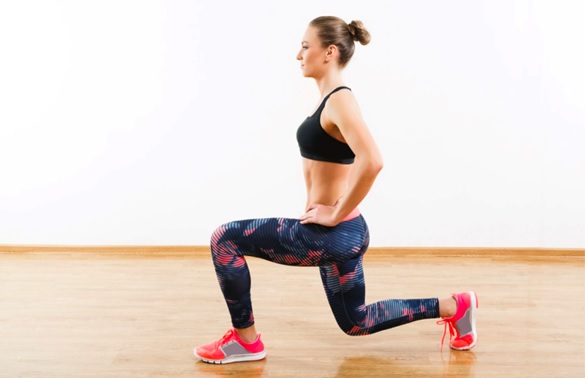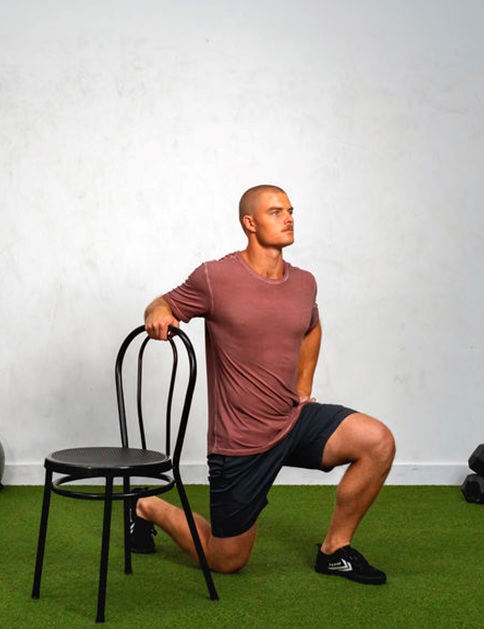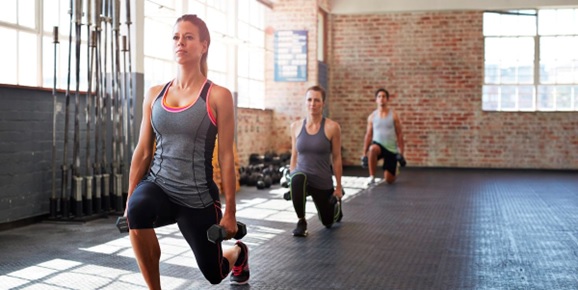
Do you have a love-hate relationship with lunges? When done correctly, lunges are one of the best foundational exercises for legs. Unfortunately many people haven’t yet nailed the technique or don’t do them often enough. We don’t blame you for feeling this way. Lunges aren’t easy. However it’s possible to learn to love them. Read below to find out why you should lunge more and how to troubleshoot your technique to make them more efficient.
Reasons To Lunge
A lunge is a compound movement meaning it uses multiple muscles at once. Although there are many variations, a basic lunge entails you standing with one foot in front of the other and bending both knees. It is similar to the squat but more balance is required. As you can imagine, lunges are great for leg strength and stability. Mastering lunges in the gym will make everyday activities like climbing stairs and getting up off the ground so much easier. Not only are they functional, they are amazing for those concerned with aesthetics. Lunges develop all the muscles of the legs including glutes, quads, hamstrings and calves. So if you want strong legs and buns of steel, you better sprinkle some lunges into your daily routine.

Start With The Basics
There is no need to dive in the deep end and begin with weighted lunges. Whenever you’re trying a compound exercise, it’s best to nail the technique before increasing intensity. If you’re really unsure about form, get help from a personal trainer or someone literate in lunging. Alternatively, you can get a home tutorial from Youtube or by reading online articles. Here is a step by step explanation on how to do a forward lunge:
- Begin with hands on hips (this will help you gauge whether your hips are staying level during the movement)
- Step one foot forward (not directly in front of the back foot but slightly out as if you are standing on train tracks)
- Squeeze your butt cheeks together and ensure your back heel is lifted off the ground)
- Bend both knees (try to get the back knee down to the ground)
- Hold at the bottom for a little pause then come up the same way you went down.

Make sure not to lean too far forward or stick your butt out to one side. A common mistake is that people leave their back heel down on the ground. Letting your front knee cave in can also occur so be mindful of this. If you follow these basic cues and work on getting comfortable in the bottom position, lunges will start to feel easier in no time.
Use A Hand Support
If going no-hands is already a bit much, try doing it with a hand support. This isn’t cheating, it’s learning. Just like how a baby uses furniture to balance when trying to walk for the first time. Having something to lean on will reduce the amount of work your stabiliser muscles have to do. Follow the procedure outlined above but instead of hands on hips, place one on a chair or kitchen bench. This is a great option for those who find balance to be the hardest part of the movement. Lunges can be difficult for numerous reasons. Some people struggle with ankle mobility while others are scared of aggravating previous injuries. Whatever the case may be, it’s best to master the easier versions before you try harder variation. Once you nail a few lunges with the help of a rail, you can challenge yourself with hands-free.

Watch Other People
You know the saying ‘monkey see monkey do’? It applies to exercise. Humans learn best by mimicking others. This is known as ‘imitative learning’. Watching someone else do perfect lunges can seriously improve your own form. Luckily it’s not hard to find footage of people lunging. Most fitness influencers will have at least one lunge workout video on their Instagram. Not to mention the plethora of Youtube tutorials you have to choose from. Just search up #lunge tutorial and millions of options will appear. You could even do it the old fashioned way and watch someone doing them in the gym. Analysing someone else’s lunge is a good way to hone your own technique, especially if you’re a visual learner. As they say, “watch and learn”. Check out what others do and then try your best to reenact. This tactic will help you level up your lunges in no time.

Try A Different Variation
Maybe you don’t hate lunges, you just haven’t found the one for you yet.
There are more lunge variations than you can poke a stick at. Dumbbell, barbell, reverse, curtsy, Bulgarian and plyometric to name a few. Each one comes with their own unique benefits. The right one for you will depend on your goals and anatomy. The length of your limbs affects your experience of the movement. Additionally, it depends on what you want to achieve. Jumping lunges are great for explosive power and increasing vertical leap but might not be ideal for those with knee injuries. Those who struggle with hip extensor mobility will find lateral lunges easier than forward ones. Curtsy lunges are great for those trying to target the gluteus medius (side butt) and overhead lunges will recruit your core muscles. All of these options look and feel very different. You might struggle with one type but love another. Give them all a go and find which one suits you best.

Conclusion
Although there are some cases where lunging movements should be avoided (e.g. those who are seriously injured), most of us should be able to do at least one variation. Lunges come with so many benefits yet not enough of us are doing them regularly. Those claiming they hate lunges probably might just be doing them incorrectly. Get a personal trainer to check your form and troubleshoot your technique. After that, experiment with a few different variations and find which one you hate the least. Soon enough, they will be your new favourite move. The only kind of lunge you regret is the one you didn’t do.
